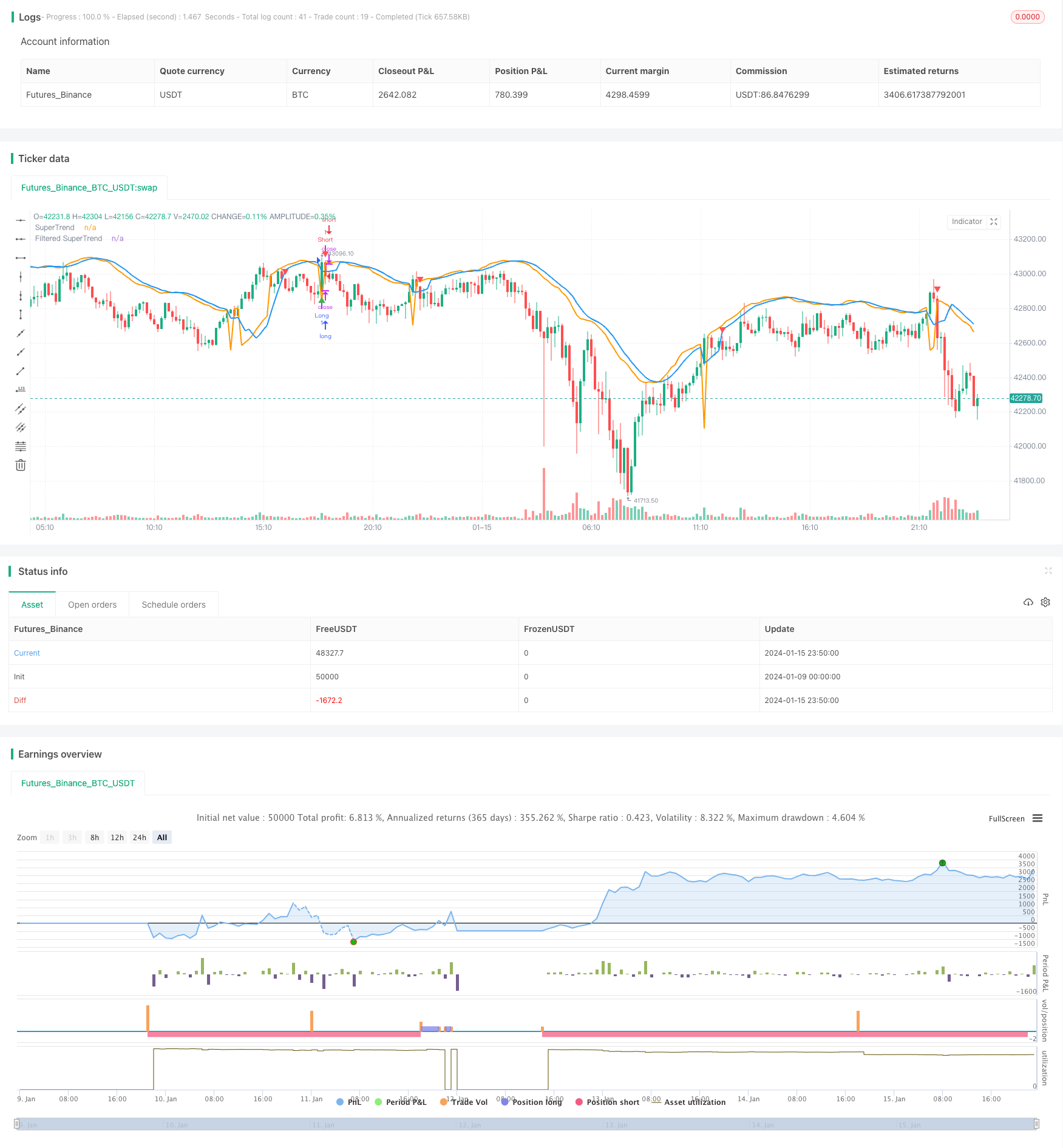Melhoria da estratégia SuperTrend
Autora:ChaoZhang, Data: 2024-01-17 15:55:15Tags:

Resumo
Este artigo analisa em profundidade uma estratégia de tendência que combina o indicador SuperTrend com um filtro RSI estocástico para melhorar a precisão.
Estratégia lógica
Cálculo da SuperTendência
Primeiro, a True Range (TR) e a Average True Range (ATR) são calculadas.
Banda superior = SMA ((fechado, período ATR) + Multipliante ATR * ATR Intervalo inferior = SMA ((fechado, período ATR) - Multipliante ATR * ATR
Uma tendência ascendente é identificada quando se fecha > faixa inferior. Uma tendência descendente é identificada quando se fecha < faixa superior.
Durante a tendência de alta, a SuperTendência é definida na faixa inferior.
Mecanismo de filtragem
Para reduzir os falsos sinais, a SuperTendência é suavizada usando uma média móvel para obter a SuperTendência filtrada.
RSI estocástico
O valor do RSI é calculado, em seguida, o indicador estocástico é aplicado a ele para gerar o RSI estocástico.
Condições de entrada e saída
Entrada longa: fechamento de cruzes acima da SuperTrend filtrada na tendência de alta e do RSI estocástico < 80 Introdução curta: Fechar cruzamentos abaixo da SuperTrend filtrada na tendência de baixa e no RSI estocástico > 20
Saída longa: Fechar cruzes abaixo da SuperTendência filtrada na tendência de alta
Saída curta: fechar cruzes acima da SuperTrend filtrada em tendência de queda
Vantagens da estratégia
Esta estratégia de tendência melhorada tem as seguintes vantagens face às médias móveis simples:
- A própria SuperTrend possui uma boa identificação de tendências e habilidades de filtragem de falsos sinais.
- O mecanismo de filtragem reduz ainda mais os falsos sinais, resultando em sinais mais fiáveis.
- O RSI estocástico evita sinais falsos em torno de níveis de suporte/resistência importantes durante condições de sobrecompra/supervenda.
- A estratégia considera tanto a direcção da tendência como as condições de sobrecompra/supervenda que conduzem a um melhor equilíbrio entre seguir a tendência e evitar falsos sinais.
- O ajustamento flexível dos parâmetros permite a adaptação aos diferentes ambientes de mercado.
Riscos e otimização
Riscos potenciais
- O stop loss pode ser atingido durante movimentos de alta volatilidade.
- Problemas de atraso com a SuperTrend e filtragem causando mudanças recentes de preços.
- Configurações incorretas do parâmetro RSI estocástico que afetam o desempenho da estratégia.
Gestão de riscos
- Ajustar o stop loss de forma adequada ou utilizar o stop loss posterior.
- Ajustar parâmetros como o período ATR e o período de filtragem para equilibrar o efeito de atraso.
- Teste e otimize os parâmetros do RSI estocástico.
Oportunidades de otimização
- Teste diferentes combinações de parâmetros para encontrar parâmetros ideais.
- Tente diferentes mecanismos de filtragem como suavização EMA etc.
- Aplicar aprendizagem de máquina para otimizar automaticamente parâmetros.
- Incorporar outros indicadores para complementar as condições de entrada.
Conclusão
Esta estratégia combina os pontos fortes do SuperTrend e do RSI Estocástico para a identificação eficaz de tendências e sinais comerciais de qualidade, ao mesmo tempo em que torna a estratégia robusta para o ruído do mercado através de mecanismos de filtragem.
/*backtest
start: 2024-01-09 00:00:00
end: 2024-01-16 00:00:00
period: 10m
basePeriod: 1m
exchanges: [{"eid":"Futures_Binance","currency":"BTC_USDT"}]
*/
//@version=5
strategy("Improved SuperTrend Strategy with Stochastic RSI", shorttitle="IST+StochRSI", overlay=true)
// Input parameters
atr_length = input(14, title="ATR Length")
atr_multiplier = input(1.5, title="ATR Multiplier")
filter_length = input(5, title="Filter Length")
stoch_length = input(14, title="Stochastic RSI Length")
smooth_k = input(3, title="Stochastic RSI %K Smoothing")
// Calculate True Range (TR) and Average True Range (ATR)
tr = ta.rma(ta.tr, atr_length)
atr = ta.rma(tr, atr_length)
// Calculate SuperTrend
upper_band = ta.sma(close, atr_length) + atr_multiplier * atr
lower_band = ta.sma(close, atr_length) - atr_multiplier * atr
is_uptrend = close > lower_band
is_downtrend = close < upper_band
super_trend = is_uptrend ? lower_band : na
super_trend := is_downtrend ? upper_band : super_trend
// Filter for reducing false signals
filtered_super_trend = ta.sma(super_trend, filter_length)
// Calculate Stochastic RSI
rsi_value = ta.rsi(close, stoch_length)
stoch_rsi = ta.sma(ta.stoch(rsi_value, rsi_value, rsi_value, stoch_length), smooth_k)
// Entry conditions
long_condition = ta.crossover(close, filtered_super_trend) and is_uptrend and stoch_rsi < 80
short_condition = ta.crossunder(close, filtered_super_trend) and is_downtrend and stoch_rsi > 20
// Exit conditions
exit_long_condition = ta.crossunder(close, filtered_super_trend) and is_uptrend
exit_short_condition = ta.crossover(close, filtered_super_trend) and is_downtrend
// Plot SuperTrend and filtered SuperTrend
plot(super_trend, color=color.orange, title="SuperTrend", linewidth=2)
plot(filtered_super_trend, color=color.blue, title="Filtered SuperTrend", linewidth=2)
// Plot Buy and Sell signals
plotshape(series=long_condition, title="Buy Signal", color=color.green, style=shape.triangleup, location=location.belowbar)
plotshape(series=short_condition, title="Sell Signal", color=color.red, style=shape.triangledown, location=location.abovebar)
// Output signals to the console for analysis
plotchar(long_condition, "Long Signal", "▲", location.belowbar, color=color.green, size=size.small)
plotchar(short_condition, "Short Signal", "▼", location.abovebar, color=color.red, size=size.small)
// Strategy entry and exit
strategy.entry("Long", strategy.long, when=long_condition)
strategy.entry("Short", strategy.short, when=short_condition)
strategy.close("Long", when=exit_long_condition)
strategy.close("Short", when=exit_short_condition)
- Estratégia de negociação de impulso inverso
- Estratégia do indicador PB de banda média
- RSI & Fibonacci Estratégia de negociação de 5 minutos
- A média móvel tripla combinada com a estratégia quantitativa MACD
- Optimização de ruptura de impulso
- Valor de mercado da posição em risco da instituição
- As bandas de volatilidade e a estratégia de negociação de tendências de ações VWAP
- Reversão de preços com estratégia de captura cruzada
- Estratégia do Ciclo Cibernético Estocástico de Ehlers
- Percussão de preço alto-baixo diário baseado em níveis de Fibonacci
- Estratégia quantitativa de negociação que integra MACD, RSI e RVOL
- Estratégia de acompanhamento da inversão do ímpeto
- Tendência de seguir uma estratégia baseada no cruzamento da EMA e da SMA
- Estratégia de negociação algorítmica de inversão de pivô simples
- Estratégia de negociação adaptativa baseada no indicador ADX
- Estratégia dinâmica de ruptura do canal
- Estratégia de negociação de banda de Bollinger com vários filtros
- Estratégia de período cruzado de média móvel ponderada baseada no intervalo real
- Estratégia de impulso duplo da SMA
- Estratégia de avanço da desviação média do ímpeto